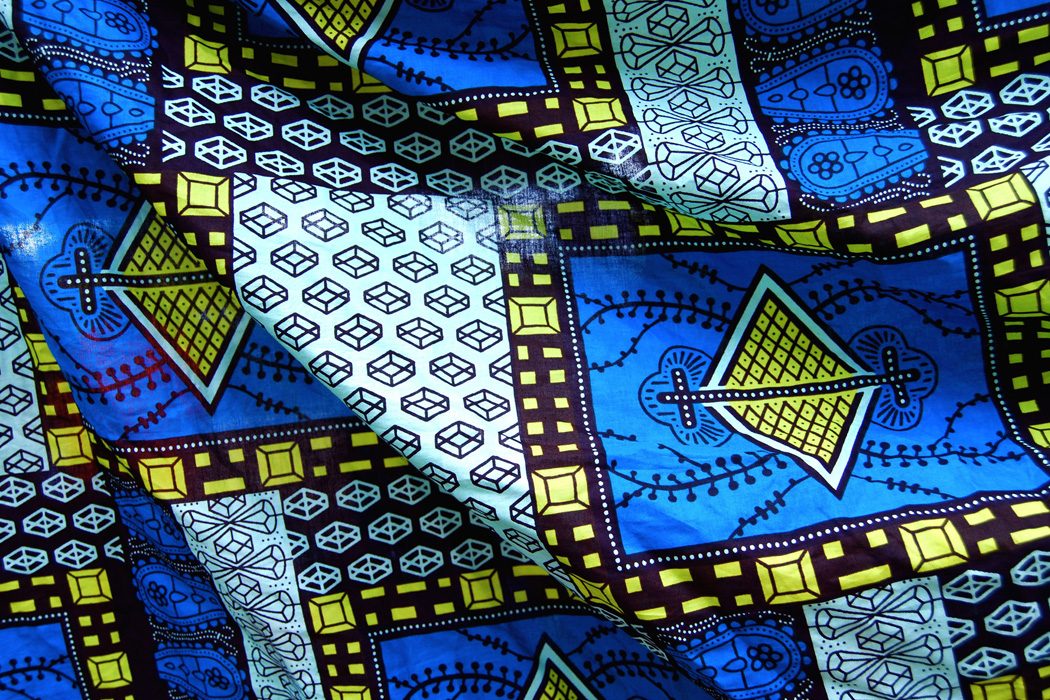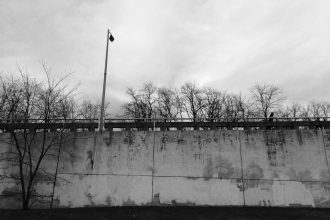Sunrises in Uganda happen suddenly. On the equator, dawn is dark, turning pink at the eastern corners at the sky at 6:00, 6:30. Then morning wakes up in a flash of pink light at 6:45. With it comes Ugandan life. In Mokono, at the university where I stayed, the monkeys climb back down the hill to campus and the resident cat meows and stretches at my windowsill. A woman walks slowly to work. The palm trees silhouette morning promise, and one person at a time, the campus fills with people.
Sometimes nothing else seems to happen quickly in Uganda. When, at the campus canteen, I ordered smoothies and coffee with the study-abroad students and staff from Uganda Christian University, our drinks would come 30 minutes later, no matter how busy the canteen is. Ugandan students, plumed in pencil skirts and ties, sometimes wander into class 20 minutes after it starts—hellos and goodbyes, handshakes and bows extended to everyone in the room. We drove slowly in Mokono because so many potholes, ridges, and gulleys fracture the road, and so many taxis, Kenyan fuel trucks, and boda-boda‘s (motorbikes) compete for space. Were I a Ugandan woman, I would navigate all this traffic as I walk from my house with no indoor plumbing to a well, carrying a yellow jug for water. Then I’d wash my clothes by hand, scrubbing one piece at time.
But I’m an American woman sitting at my patio outside my Midwestern brick ranch, June heat taking me back to East Africa. I spent five days there at a study-abroad program, learning how American college students experience “the Pearl of Africa” over a semester. I am an American woman, so I stayed in a guesthouse with internet and running water, and had breakfast delivered to my table each morning. Before heading to class or a practicum visit, I’d take a photo of the vines twisting up the porch and the monkeys leaping in the low trees, and think I could get used to this. Then I climbed in the van, bumping and swaying my way to visit the NGO practicum sites where the American students worked with neglected street children and blind children learning to read Braille. The teachers alternately praised and caned the children. Signs on the playground announced SPEAK ENGLISH SAY NO TO SEX. The American students showed us the children’s dorms, each bed covered in a mosquito net, with that child’s tiny underwear and t-shirts drying on the bunk bed rails. Later, the students and I navigated the potholes back to the canteen for coffee and samosas. What is hard about Uganda? What will you miss? I asked. Their answers: Everything. Everything.
Three months later, I’m trying to parse the everything while trying to remember what I loved. A place that I previously associated with homophobia and poverty now makes me think of tropical flowers, monkeys, and lively open air church services. My nostalgia is problematic. Uganda is still a place with poverty, homophobia, violence, disease, and ignorance—like America, but on the other side of the world, making it easy to picture only the flowers and monkeys. Why does the thought of a place that soaked my shirts with humidity and stained my shoes with red dirt and could have given me typhoid and malaria fill me with a powerful urge to return?
Travel has always pared my life down to simpler and simpler needs; it is too hard to carry around very much while digesting the complex world. Uganda pared me down even more: I lived out of one bag; I carried a small purse and spent little money. Each meal, I ate the same fruit, samosa, rice, and beans, and walked up and down a hill to a small room with two beds, two mosquito nets, two light bulbs, intermittent wifi, and a lukewarm shower. This was almost too much.
I learned that Uganda, and Ugandan people, are beautiful, hospitable, and kind. Yet terrible things can happen suddenly in Uganda and take 30 years to undo. The weekend before I came, the American students visited Gulu in northern Uganda, for their cross-cultural practicum, then debriefed it in class. Joseph Kony (remember Kony 2012 and Invisible Children?), warlord of the Lord’s Resistance Army (LRA) and self-described messiah, abducted thousands of women and children in this region. The male children became child soldiers. The women were raped, tortured, forced to give birth to their captors’ children, and forced to watch those children go on to become child soldiers and sex slaves themselves.
Afterwards, those women and children struggled to exist in communities that resist “Kony’s children” or “Kony’s wives” living among them. Organizations like Amani work with the women to create fair trade products. As they sew, they tell their stories of being abducted at age eight or nine, enduring life as a captive wife or concubine to to the soldiers, and then giving birth to their captors’ children. The women create an economic future this way and “shar[e] God’s peace holistically.”
The students also visited the Recreation Project, created by a Colorado man who had worked in a displacement camp as a psychologist. Having found that his American training to tell victims to “just tell your story” wasn’t helping the children in the camp get better, he decided that children affected by the war needed to experience childhood for the first time. At the Recreation Project, children can ride a zip line, participate in a ropes course, and learn agricultural training. The last is something 80% of Ugandans need to financially survive, but the generation released from the LRA had lived in the bush as child soldiers when they should have been learning how to farm. In addition to teaching them these skills, the Recreation Project also created a parent-child group, where mothers and their child soldiers (that they might struggle to love) could learn to talk to each other.
“What about the Women’s Advocacy Network?” the professor asked.
“I was afraid you were going to ask that,” one of the students said, grimacing.
“You mean it gets worse?” I asked.
“Oh,” they sighed again.
The Women’s Advocacy Network advocates for female victims of war crimes, and it is made up of some of the most prominent, abused women the LRA has abducted and tortured since 1986. When they escaped or were freed, they struggled to find work and reintegrate into their communities, which often leads them to abusive relationships. The women have reconciled with their tortures, sometimes saying, “I’ve already endured the worst,” but the students have not.
“All explanations [of suffering] must proceed from a sense of failure,” Denise Ackermann, South African feminist theologian writes in After the Locusts: Letters from a Landscape of Faith. The American students could not explain the LRA violence in Gulu or the suffering they continued to witness in Mokono. One student visited her Compassion child, learning the little girl has sickle cell, and is always sick. Another wrote about visiting a child with cerebral palsy, whose father abandoned the mother and three children after the disabled child was born. The boy lay alone on a blanket most of the day while the mother went out looking for food, and the food would knot up in his stomach, not digesting. Another student worked at an NGO designed to protect street kids. She told us that during the election, a local toddler was sacrificed, allegedly for peace during the elections.
“Can you explain what you mean by child sacrifice?” I asked, thinking I missed something. But I haven’t. The toddler was killed, as children sometimes are, maybe because a tribal leader said a child sacrifice would bring peace, or good luck to a business, or resolve an insurmountable problem. Or, as one of the social workers suggested, Ugandan women suffer postnatal depression just like other women do, and have to find a reason to explain what they have done.
In the cross-cultural class, the students shared these stories. Perhaps they were remembering the seemingly-pointless American lives and supermarkets they’d be returning to at the end of April. Perhaps they were thinking of their own suffering. Perhaps they could only think of these women and small children. “Do you feel more at peace or are your hearts heavier?” the professor asked the students toward the end of class. “Heavier,” one student said. “Kony is still alive, cutting off elephant tusks and selling them.”
“We must remember in order to redeem,” Ackermann writes of her childhood in apartheid South Africa. “Otherwise there will be no justice.” The American students remember the looks on women’s faces; they think of children abandoned by relatives or maimed by disease. I think of Joseph Kony slaughtering elephants to sell to smugglers, and remember photos of white CEOs posing with dead rhinos and lions. Destruction stalks the whole world, but it oppresses in Uganda. We were remembering. Where was the justice?
That I traveled to Uganda during Holy Week, a week of so much promise mixed with horror, is not lost on me. I would always prefer to skim over the gospel descriptions of Jesus’ torture, as I would prefer to look away from the Ugandan women lugging their burdens of water and children. If I don’t look, I don’t have to imagine myself under those burdens, that whip, flail, cross, and I don’t have to struggle with the failure of words.
Yet by looking away, I—we—abandon redemption and justice.
Because what also lingers with me now is how necessary this struggle against injustice and violence is in Uganda. The students mentioned a woman at the WAN who could not stop smiling. She was so happy they didn’t think she had a reason to be there, until she started telling her story. It was one of the most horrific they heard, and also had one of the happiest endings. Most women do not have wedding rings, because rings only come with a more expensive wedding. This woman, however, had not only married a kind man who put aside her connection to Kony, but also paid for a gold wedding ring. If the students look away, they miss someone’s hard-won happiness.
My part of America has no monkeys or tropical flowers, but plenty of injustice we’d all prefer to ignore; this week some of my students resisted reading Ta-Nehisi Coates’ Between the World and Me, saying, “I’m just so tired of hearing about these shootings.” People try to disregard our country’s newest and worst mass shooting by blaming it on homosexuality or Muslims. My middle-American city is littered with meth houses, child abuse, and unemployment, and at my mostly white, upper-middle-class university, I meet students who grew up without furniture or regular meals and lost multiple siblings to gun violence. Students of all financial backgrounds and ethnicities tell me of their abuse by someone they trusted, their addictions, and their terror of God. Looking hurts like hell. But if I look away, I miss their hard-won happiness: their first 30 days sober, their family’s first college graduation, their first few minutes of peace with God.
Uganda reminds me that looking away from one thing means missing everything. Like the monkeys tumbling in a tree. The lizard scurrying across my TV cable. The cat’s invitation to scratch her ears. The mango juice. A stranger’s beautiful smile. The whole sky flashing a sudden resurrection pink.





